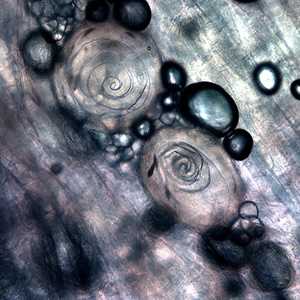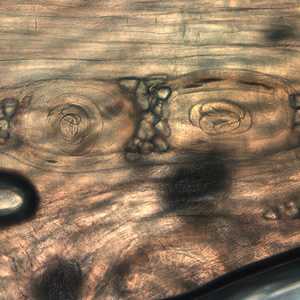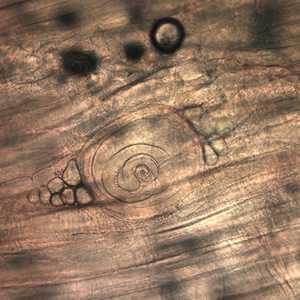
Case #199 - March, 2007
A huntsman killed a bear and prepared it for eating and freezing by cutting it into roasts, steaks, and grinding the trimmings. Later that same day, he ate a burger made from some of the fresh meat and cooked rare. Approximately two and a half to three weeks later, the hunter experienced fever, diarrhea, and muscle pain. However, medical attention was not sought for another six weeks. He had elevated eosinophilia and several laboratory tests were ordered. The Division of Parasitic Diseases’ reference diagnostic laboratory received some of the bear meat for examination. A digestion technique using 0.1% pepsin and 0.1% hydrochloric acid was used on the meat and a muscle squash was made from the softened tissue. Figure A, taken at 400× magnification, and Figures B-E, taken at 1000× magnification, show what was observed. What is your identification of the objects in the meat? What is your diagnosis? Based on what criteria?

Figure A

Figure B

Figure C

Figure D

Figure E
Case Answer
The objects observed in the meat were larvae of Trichinella sp. Diagnostic features included the presence of encapsulated, coiled larvae located in muscle tissue of the bear, which is consistent with some Trichinella spp. Serologic testing was performed on serum from the patient and was positive for Trichinella by EIA.
More on: Trichinellosis
Images presented in the monthly case studies are from specimens submitted for diagnosis or archiving. On rare occasions, clinical histories given may be partly fictitious.
DPDx is an education resource designed for health professionals and laboratory scientists. For an overview including prevention and control visit www.cdc.gov/parasites/.
- Page last reviewed: August 24, 2016
- Page last updated: August 24, 2016
- Content source:
- Global Health – Division of Parasitic Diseases and Malaria
- Notice: Linking to a non-federal site does not constitute an endorsement by HHS, CDC or any of its employees of the sponsors or the information and products presented on the site.
- Maintained By:


 ShareCompartir
ShareCompartir